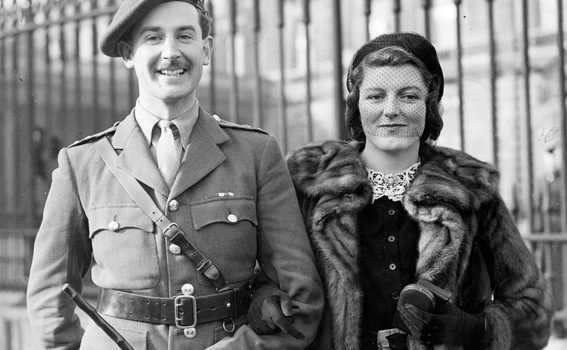Introduction
Brigadier Simon Christopher Joseph Fraser, the 15th Lord Lovat, was a Scottish nobleman, war hero, and one of the most remarkable figures of World War II. Best known for his leadership of the British commandos during the D-Day landings, he was a charismatic and unconventional leader whose exploits have become legendary. Lovat’s legacy as a fearless soldier, his role in the Commandos, and his Highland warrior spirit make him one of the most fascinating military leaders of the 20th century.
Early Life and Background
Simon Fraser was born on July 9, 1911, into the noble Clan Fraser of Lovat, a Scottish family with a long military tradition. He was educated at Ampleforth College and later attended Oxford University, where he developed an interest in military history and leadership.
His aristocratic background and family’s military history influenced his decision to join the Scots Guards in 1930. However, his early years in the army were relatively uneventful, and he resigned his commission in 1933 to focus on managing his family estate.
World War II and the Commandos
At the outbreak of World War II, Lovat rejoined the British Army and was assigned to the Lovat Scouts, a reconnaissance unit originally raised by his ancestors. However, his real fame began when he volunteered for the Commandos, an elite special forces unit established by Prime Minister Winston Churchill for carrying out daring raids on enemy-occupied territory.
The Commandos and Raids on Occupied Europe
Lovat quickly rose through the ranks due to his leadership skills, bravery, and innovative tactics. He became a commander of No. 4 Commando, leading the unit in daring operations along the French coast.
One of his first major engagements was Operation Archery (1941), a raid on the German-occupied Norwegian island of Vågsøy. This raid disrupted German operations and provided vital intelligence for future missions. His ability to inspire loyalty and lead from the front became well-known, and he earned the respect of both his men and his superiors.
In 1942, Lovat took part in the Dieppe Raid, an ill-fated Allied attack on the German-held port of Dieppe, France. Despite the raid’s disastrous outcome, the Commandos under Lovat’s leadership successfully completed their objectives and withdrew with minimal losses. His experience in Dieppe would later shape his strategy for D-Day.
D-Day: The Greatest Amphibious Invasion
Lord Lovat’s most famous moment came on June 6, 1944, during the D-Day landings. He was given command of the 1st Special Service Brigade, a key force in the Normandy invasion.
Landing at Sword Beach
At the head of his Commando unit, Lovat landed at Sword Beach, one of the five main invasion beaches. True to his aristocratic warrior image, he led his men wearing a white sweater under his battle dress and armed with a rifle instead of a standard officer’s pistol.
In one of the most iconic moments of D-Day, Lovat’s personal piper, Bill Millin, played the bagpipes as the Commandos advanced under fire. Millin played despite the German snipers targeting the beaches, as Lovat famously insisted that “it was tradition” for Highland troops to be led into battle by the sound of the pipes. This act of defiance and morale-boosting courage has become legendary.
Linking Up with the Paratroopers at Pegasus Bridge
After landing, Lovat led his men on a rapid 5-mile march inland to relieve the British 6th Airborne Division, who had captured Pegasus Bridge over the Caen Canal in a daring glider assault.
Lovat’s arrival at the bridge was a dramatic and historic moment. As he marched his Commandos across the bridge, Millin played the bagpipes once again, reinforcing the morale of the airborne troops who had been holding the position under intense German counterattacks. His unit played a crucial role in securing the bridge and ensuring that reinforcements could move deeper into Normandy.
For his leadership and bravery on D-Day, Lovat was awarded the Distinguished Service Order (DSO).
Post-D-Day and Wounded in Action
After the successful landings in Normandy, Lovat continued to lead his brigade in combat. However, his war service was cut short when he was severely wounded by German artillery during the advance inland. He was evacuated to Britain and never returned to active frontline service.
Despite his injuries, Lovat remained deeply involved in military affairs and the rebuilding of Britain’s post-war armed forces.
Later Life and Legacy
After the war, Lord Lovat returned to Scotland and focused on his family estate. He also entered politics, serving as Minister of Economic Warfare in Winston Churchill’s government.
In Popular Culture
Lovat’s exploits made him one of the most celebrated British war heroes, and he became a legendary figure in both military and popular culture. He was portrayed in the 1962 war film The Longest Day by Peter Lawford, capturing his remarkable leadership on D-Day.
Death and Remembering Lord Lovat
Simon Fraser, 15th Lord Lovat, passed away in 1995 at the age of 83. He is remembered as one of Britain’s greatest wartime leaders, and his legacy lives on through the continued traditions of the British Commandos and the Highland Regiments.
Conclusion
Brigadier The Lord Lovat was a warrior, leader, and aristocrat who left an indelible mark on history. His fearless leadership, especially during the D-Day landings, remains an inspiring example of courage and determination. Whether leading his men through the fires of Normandy, marching into battle with the sound of bagpipes, or recovering from war wounds with the spirit of a Highland chieftain, Lovat embodied the very essence of British resilience and heroism. His story continues to inspire soldiers and historians alike, ensuring that his name and deeds will never be forgotten.

